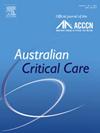Employer-provided wellbeing support for nurses working in intensive care units: A national cross-sectional study
IF 2.6
3区 医学
Q2 CRITICAL CARE MEDICINE
引用次数: 0
Abstract
Background
Intensive care units are characterised as high-stress work environments that may negatively affect nurses’ wellbeing. Employer-provided support has a crucial role in reducing burnout and improving wellbeing.
Objective
The aim of this study was to examine wellbeing supports routinely offered by employers of nurses working in intensive care units and examine the relationships amongst perceived organisational support, wellbeing, and burnout.
Methods
A cross-sectional study of nurses working in Australian intensive care units was conducted from 4 to 19 September 2023. A web-based survey was distributed via the Australian College of Critical Care Nurses and social media, with snowball sampling. Validated tools for perceived organisational support, subjective wellbeing, and burnout were used.
Results
Of 668 responses, 632 met inclusion criteria for analysis (94.6%). Education and training were the most common supports recognised by nurses (63.4%, n = 401). The most helpful support was childcare assistance (M = 3.17, standard deviation [SD] = 1.38). Higher levels of perceived organisational support were associated with better subjective wellbeing (r = 0.20; p < 0.001). Perceived organisational support was higher for nurses without burnout (M = 4.15, SD = 0.89) than for those with burnout (M = 3.64, SD = 0.85; t [625] = 7.43, p < 0.001, two-tailed). For every one-point increase in the mean value of perceived organisational support, nurses were 56% less likely to report experiencing burnout than those who perceived lower organisational support (B = −0.81, p < 0.001, odds ratio = 0.44, 95% confidence interval: 0.35–0.56). The strongest predictor of reporting burnout was engaging in an education/clinical support job role (B = 0.88, p = 0.04, odds ratio = 2.41, 95% confidence interval: 1.04–5.60).
Conclusions
Nurses working in Australian intensive care units perceived employer-provided wellbeing support to be inadequate. Perceived organisational support is a modifiable independent predictor of burnout, suggesting that employers need to work with nurses to improve wellbeing supports.
Registration
Not registered.
雇主为在重症监护室工作的护士提供的福利支持:一项全国性的横断面研究
重症监护室的特点是工作环境压力大,可能会对护士的健康产生负面影响。雇主提供的支持在减少倦怠和改善幸福感方面发挥着至关重要的作用。目的本研究的目的是检查在重症监护病房工作的护士的雇主提供的日常健康支持,并检查感知组织支持,健康和倦怠之间的关系。方法对2023年9月4日至19日在澳大利亚重症监护病房工作的护士进行横断面研究。一项基于网络的调查通过澳大利亚重症护理护士学院和社交媒体进行了分发,采用滚雪球抽样。使用了感知组织支持、主观幸福感和倦怠的有效工具。结果668例应答中,632例(94.6%)符合纳入标准。教育和培训是护士最常见的支持(63.4%,n = 401)。最有帮助的支持是托儿援助(M = 3.17,标准差[SD] = 1.38)。更高水平的组织支持感知与更好的主观幸福感相关(r = 0.20;p & lt;0.001)。无倦怠护士的组织支持感(M = 4.15, SD = 0.89)高于倦怠护士(M = 3.64, SD = 0.85;[625] = 7.43, p <;0.001,双尾)。感知组织支持的平均值每增加1点,护士报告感到倦怠的可能性比感知组织支持较低的护士少56% (B = - 0.81, p <;0.001,优势比= 0.44,95%可信区间:0.35-0.56)。职业倦怠的最强预测因子是从事教育/临床支持工作角色(B = 0.88, p = 0.04,优势比= 2.41,95%可信区间:1.04 ~ 5.60)。结论在澳大利亚重症监护病房工作的护士认为雇主提供的福利支持不足。感知到的组织支持是一个可改变的职业倦怠的独立预测指标,这表明雇主需要与护士合作,以改善福利支持。RegistrationNot注册。
本文章由计算机程序翻译,如有差异,请以英文原文为准。
求助全文
约1分钟内获得全文
求助全文
来源期刊

Australian Critical Care
NURSING-NURSING
CiteScore
4.90
自引率
9.10%
发文量
148
审稿时长
>12 weeks
期刊介绍:
Australian Critical Care is the official journal of the Australian College of Critical Care Nurses (ACCCN). It is a bi-monthly peer-reviewed journal, providing clinically relevant research, reviews and articles of interest to the critical care community. Australian Critical Care publishes peer-reviewed scholarly papers that report research findings, research-based reviews, discussion papers and commentaries which are of interest to an international readership of critical care practitioners, educators, administrators and researchers. Interprofessional articles are welcomed.
 求助内容:
求助内容: 应助结果提醒方式:
应助结果提醒方式:


